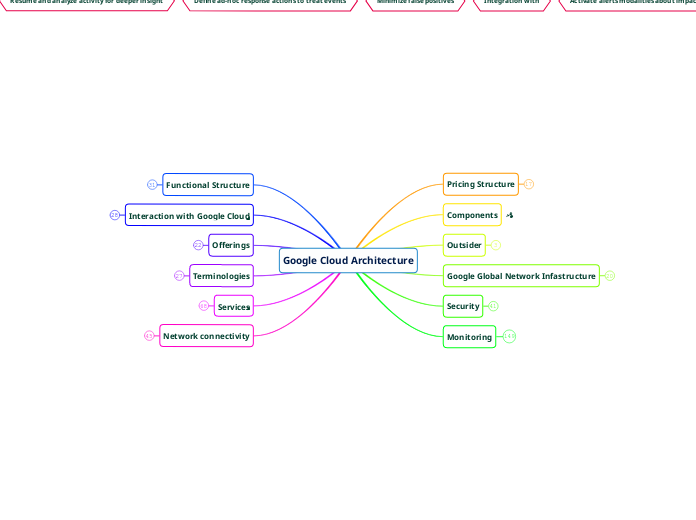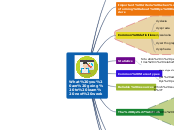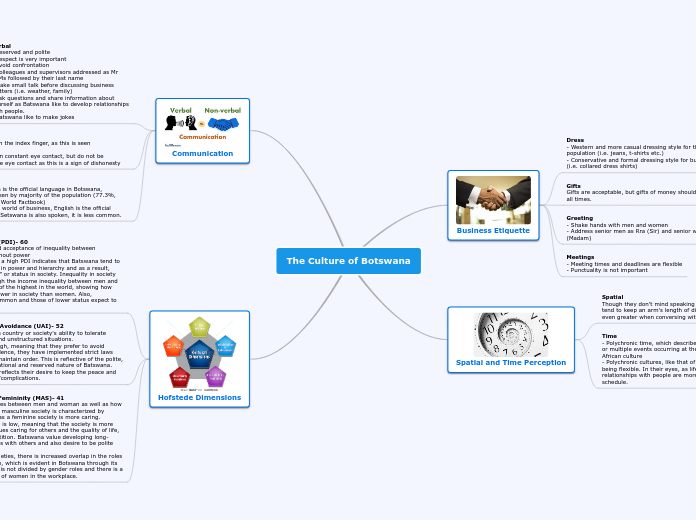Key Features
Activate alerts modalities about impacted assets
Integration with
Minimize false positives
Define ad-hoc response actions to treat events
Resume and analyze activity for deeper insight
Things are not istantaneuos
For service reliability ends, all parts should agree they are accurate measure of the user experience AND consider as primary driver for decision-making
Allowing applications to respond to user requests from the location that will provide the quickest response time.
Divided in Regions
Are changable
Generally pretty broad set of permission altogheter
Non supportano IPv6
Google Cloud Architecture
Network connectivity
Homogenous (G's - G's)
VPC
VPC Peering
Communication happens through private IP
Each GCP network admin pairs their network with the other
Outside same organization
Shared VPC
The GCP are connected through an ad-hoc and private generated network
Whitin same organization
To create a dedicated, private connection between different GCP, both from same organization node or not
Hybrid (G's - Own)
Type
There is no SLA for peering
Connection is enstablished at the PoPs (GCP's Edge Points of Presence), where Google's network connects to the rest of the Internet via peering
it's an access service not only to GC infrastructure, but to the whole Google's services
Access: External IP
Carrier peeting
If direct is no option,several provider offer to work as a bridge
Capacity: Dipend on carrier
Enstabliscing a direct connection whit Google in a PoP
Requires: Connection in peering facility
Capacity: 10 Gbps / link
Interconnecting
Physical linking between networks points of access (PoA) whitin a data center
Shared
If Dedicated is no option, several provider offer to work as a bridge
Requires: Service provider
Capacity: 0.5 - 10 Gbps / connection
Dedicated
Install an owned router whitin a data center hosting a Google PoA and directly link them
Requires: Connection in colocation facility
Capacity: 10 - 100 Gbps (100 in beta) / link
VPN
Create IPsec(ured) tunneling through data encription performed by gateways at each networks ends
Access: Internal IP
Requires: On-prem Gateway installation
Capacity: 1-5-3 Gps / tunnel (scalable)
Aim
To connect on-prem network with G's Network, by creating a direct link between owned resources and GC resources
Internal IP is generated throug link-local BGP routes
Services
Load ballancing
Global
TCP proxy
SSL proxy
HTTP(S) Load Balancing
3.5 A network endpoint group (NEG) is a configuration object that specifies a group of back-end endpoints or services
Internet NEG
Specified by "FQDN:[port]" or "IP:[port]"
A single, hybrid connectivity pointing to Traffic Director services outside G Cloud
Zonal NEG
1 or more endpoints (VMs istances or containers)
Serverless NEG
Points to Cloud Run, App Engine, Cloud Functions services residing in the same region
Contains no end-points
3. Backend service
Priority is given to geographycal vicinity and, if available, based on session affinity
Runs healty checks and routes the request based on the required load balancing criteria
2. Target proxy / URL Map
Receives request from 1., and checks the request against an URL map for the most appropriate backend service
1. Global forward Rule
In case of HTTPS, the target proxy ned to hold a valid SSL certificate
IPv4/IPv6, scalable, require no prewarning, content base, Icross-regional
Regional
Internal HTTP(S)
Network TCP/UDP
Internal TCP/UDP
Managed Instance Group
Healty check managment
Criteria are
Unhealthy threshold
How many failed attempts are decisive
Healthy threshold
How many successful attempts are decisive
Time-out
How long to wait for a response
Check interval
How often to check whether an instance is healthy.
Creation and crsahing of instances from outside the group command are recovered
Autoscale is brought on based on group functional targets (CPU usage, load balancing, total capacity, budget, ...)
It's a group if identical (VMs) istances generatd by template and managed as a whole
Conecting networks to Goolge VPC
Peering
It's not covered by Google Service Level Agreement (SLA)
gives direct access to Google Network
Carrier Peering
Using a 3rd partner service provider, the costumer network can be peered to those Google products that are exposed through a public IP
Direct peering
Placing a router in the same data center as oa Google point of presence
Interconnect
Partner Interconnect
Useful if
The data connection needs are lower then 10GB/s
the data center cannot be reached by Dedicated Interconnect
Connectivity between an on-premises network and a VPC network through a supported service provider.
Dedicated Interconnect
If the connection topologies meet G's specifications, SLA is covered up to 99.99%
Highest uptimes possible
1 or more private direct, connecting onto Google
IPsec VPN protocol
con
bandwith reliability
Security concerns
pro
New subnet will be automatically added to the connection
A "secure Internet Protocol" generated to create a tunnel connection
Terminologies
Connections
Layer 3 Vs Layer 2
Layer 3 connections provide access to G Suite services, YouTube, and Google Cloud API's using public IP addresses
Layer 2 connections use a VLAN that pipes directly into your GCP environment providing connectivity to internal IP addresses
Shared Vs Dedicated
Dedicated connections provides a direct connection to Google's network
Shared connections for a connection to Google's network through a partner
Labels
Useful for
Further specification
Billing indexing
Inventory purposes
Comprises of
A value ('HomeVM','Amagis','testing','ThomasEdison','ABC01234'...)
A key ('name', 'company', 'aim','contact','cost center'...)
String attributes attacheable to a resource (up to 64 each)
APIs
Following modification to the app implementation will be performed without altering the interface.
In case of need, the versioning of the interface allows for legacy compatibility
It's an user-friendly interface that allows the user to program the application hiding the unnecessary complexities
Containers
The host machine it' s called "node", since it it one of many to host a replica (shared workload) or a copy (same workload, for redundancy)
From the host, it only requires a conitainer-supportive OS and a cointener runtime service
They joins scalability of the workload from PaaS with the flexibility (HW adaptability and HW adjustability) from IaaS
It can be deployed with just the required system specification (adaptability), and be redefined (adjustability) on demand, and it is coordinated whitin the cloud with just the required number of replicas of itself required to share actual workload (scalability), which are much quicker then an ordinary VM to be booted or stopped.
It's a dedicated portion of both the OS kernel and User memory, which are can therefore be quickly operative, as a sealed environment, through few system calls
From the host PoV is assimilable to a service, from the guest software PoV is a VM.
Moreover, for the whole aplication (that they are built for) PoV, each guest software is a microservice.
Offerings
SaaS: Software as Service
Not installed on local PC but run on the cloud
PaaS: Platform as Service
What they use
Bind code to libraries that provide access to the infrastructure application needs.
More resources to be focused on application logic
IaaS: Infrastucture as Service
Users pay for:
What they allocate in advance
Simila to Data Centers
Provide
Network Capabilities
Storage
Raw Compute
Managed Infrastructure - Managed Services
Allows
Companies to concentrate on their goal rather than on maintaining tecnica linfrastructure
Serverless
Eliminate need for infrastructure management
Allows developers to concentrate on code
Interaction with Google Cloud
Cloud Console Mobile App
Alerts and incident management
Generate custom graphic showing metrics
Controll billing and set up alerts
Administer application deployed on App Engine
Start and Stop Cloud SQL instances
Start, stop, and use SSH to connnect to Computer Engine instances and see Logs
Application Programminf Interfaces (APIs)
Plenty of libraries for APIs coding in different languages
Within the Google Cloud Console there is the Google APIs Explorer
All Google Cloud services comes with an API so that is possible write code to control them
Cloud SDK and Cloud Shell
Cloud Shell
Includes Cloud SDK and other utilities fully available, updated and authenticated.
It's actually a Debian-based VM with persistent 5 GB home dir
Provides commmand-line access to cloud resources from browser
Cloud SDK
Set of tools usefull to manage resources and applications
....
bq - a command line tool for BigQuery
gsutil - provides access to Cloud Storage from cmd line
gcloud tool - the main command line interace
Google Cloud Console
The web-based Graphical User Interface
provides
SSH connection via browser
Find resources, check status, manage them, set budgets
Easily deploy, scale, and diagnoe prdouction issues
Functional Structure
The resource hierarchy relates with the policies
IAM Best Practices
When possibile use Identity Aware-Proxy (IAP) tool
On Service Accounts
Enstablish key rotation policies and methods
And audit keys with "serviceAccount.keys.list()" method
When creating one, use a clear explanatory name based on its purpose
Even better if a naming convention is enstablished
Be careful when granting "serviceaccountuser" role, since the account will receive all the permission granted to the service
On Policies
When possible grant roles to groups instead to individuals, then...
Control the ownership of the groups used in IAM policies
Audit membership of groups used in policies
Audit members of groups used in policies
Audit policies in Cloud Audi Logs: setiampolicy
Use "principle of least priviledge" when assign roles
Check the policy granted on each resources and make sure to understand their inheritance
Use projects to group resources that share the same trust boundary
Policies are inherited downward
Can be defined to all but the resource level, and for some services also to resource level
4 levels resources hierarchy
4. Resources
Each belongs to exactly one projects
3. Projects
Can have several owner and users
If it's under an organization node, its identity will automatically be an owner
Are the basis for the use of Google services
2. Folders
Require a Organization node
1. Organization
Either your organization has a Google Workspace domain, or you will need to create an identity by Cloud Identity
Monitoring
Integrated Observability Tools
Manage Incidents
With
SLO compliancy
Error Reporting - to assist developers work
Alerts - Automatically from data signal, end eventually directly to personnel in key role
Visulalize and Analyze
by using
Profiler - from running Apps
Snapshot Debug - from running Apps
Health Checks - from Services (uptime and latency when facing external sites)
Service Monitoring - fron Ervices (compliances with SLO) and Error alerts
Logs Explorer - from Logs
Metrics Explorer - from Signal Data
Dashboards - from Signal Data
Capturing signals
Are divided in
Trace - for Apps
Logs - for Apps, Services, Platform,
Categorized in
Service Logs: created by developers deploying code to Google Cloud.
Network Logs: Network and Security operations
NAT Gateway - capture information on NAT network connections and errors
Firewall Rules - allows to audit, verify, and analyze the effects of your firewall rules
VPC flows - records samples of VPC network flow and can be used for network monitoring, forensics, real-time security analysis, and expense optimization
Agent Logs: generated by a G's agent installed on AWS or G's Cloud VM instances to ingest the log these generate
Cloud Audit Logs: helps answer the question "Who did what, where, and when?"
Access Transparency - capture the actions Google personnel take when accessing your content
System events - non-human Google Cloud administrative actions that change the configuration of resources
Data access - tracks calls that read the configuration or metadata of resources and user-driven calls that create, modify, or read user-provided resource data
Admin activity - tracks configuration changes
Metrics - for Apps, Services, Platform, Microservices
Integrated in all G's Tools from the hardware layer up
Targets sets for the signals
SLAs - Service Level Agreements
To set alert threshold considertably higher then what defined as minimum
Include compensation in case of paying costumer if not respected
The minimum levels of service promised to provide AND what happens when not respected
Commitments made to the client that systems and applications will have only a certain amount of “down time”
SLOs - Service Level Objectives
To be something short of 100%, like 99.9% ("3 nines")
Have concrete, well-documented consequences in case of failure to meet the objectives
be S.M.A.R.T.
Time-bound (or it become ephimeral)
Relevant (to the defined goals)
Achiavable (realistic at the actual conditions)
Measurable
Specific (as in not subjective)
The target value for a monitored metric
SLIs - Service Level Indicators
It's suggested
as the ratio: # good events / # all valid events.
Should
Have a close linear relationship with the users' experience of that reliability
Are
Selected monitoring metrics that measure one aspect of a service's reliability
The 4 golden signals
Errors
# of dropped connections
Servers that fail liveness checks
# of stack traces
# of exceptions
# of failed requests
# of 400/500 HTTP codes
Wrong answers or incorrect content
Oftern arise when
a flaw, failure, or fault in a computer program or system causes it to produce incorrect or unexpected results, or behave in unintended ways
The momento to send out an alert
Service level objective violations
Configuration or capacity issues
They are importante because
They may indicate that something is failing
They are
Events that measure system failures or other issues
Saturation
# of users on the system
# of of available connections
Memory quota
Disk quota
% CPU utilization
% disk utilization
% cache utilization
% memory utilization
% thread pool utilization
Degrading performance as capacity is reached
It's an indicator of how full the service is
The residual avaiability of the most constrained resources
Traffic
To note
Is often a subjective measure depending on the application type
# of active connections
# of read ops
# of write ops
# of active requests
# of retrievals per second
# of transactions per second
# of concurrent sessions
Network I/O
# of requests for static vs. dynamic content
# of HTTP requests per second
User appreciation
infrasctructure spending
Capacity planning
It's important because
It’s an indicator of current system demand
how many requests are reaching the system
Latency
Some metrics
...
Time to complete data return
Time to first response
Transaction duration
Service response time
Query duration
# of request waiting for a tread
Page load latency
Can be related to
Measurement of system improvment
Capacity demand
Emerging issues
It's importante because
Directly affect the user experience
It measures
How long it takes a specific task to return a result
We need
Monitoring tools that help provide data crucial to debugging application functional and performance issues
Automated alerts. Even better option is to construct automated systems to handle as many alerts as possible so humans only have to look at the most critical issues
Dashboards to provide business intelligence so our DevOps personnel have the data they need
Our products to improve continually, and we need data we can receive from monitoring for this
Transparency is key to building trust
Is defined as: "Collecting, processing, aggregating, and displaying real-time quantitative data about a system, such as query counts and types, error counts and types, processing times,and server lifetimes."
It's the fundation of production reliability - Site Reliability Engineering (SRE)
Security
Google's operational security layer
Software stringent development practice
Vulnerability Rewards Programs
provides libraries that prevent developers from introducing certain classes of security bugs
two-party review of new code
central source control
Employee Universal Second Factor use
Reducin insider risk
Aggressively limits and actively monitors the activities of employees
Intrusion Detection
Rules and machine intelligence
Internet Communication layer
Denial of Service Protection
Multi-tier and multi-layer protections
Sheer scale of the infrastructure is a first layer of protection
Google Front End ("GFE")
Protection against Denial of Service attacks
Best practise are always in place
Every TLS cconnections are ended by public-private key pair and an X.509 certificate
Storage service latyer
Encription at rest
Data in physical storages are encripted by centrally managed keys and tipically accesed by storage services
Google’s central identity service
On user demand, 2nd factor identification
Request of further info, based on risk factors
Service deployment layer
Google’s services communicate with each other using RPC (remote procedure call) calls
Whitin Data center: Hardware cryptographic accelerators - Ongoing
Between DataCenter: Encryption of all inter-service RPC communication - Already in place
HW 3 layers
Premisis security
Third-party Data Center
Limited access
Physical protections
Secure boot stack
base operating system image
kernel
bootloader
Cryptographic signatures over the BIOS
Infrastructure is custom designed
Security chips
Google Global Network Infastructure
Geografical structure
Allows for
Reduce distance between endpoints
Reduce redoundancy by selecting the deploying areas
Protection from localized event
Low Latency
Measures the time a package takes to reach destination
Durability
Availability
5 Locations
Australia
Asia
Noth America
South America
Europe
Designed for
Averaging more than 100 content caching nodes worldwide
High demand content is cached for quicker access
Lowest possible latencies
Highest possible throughput
Outsider
Open Source systems
Tensorflow
Open source software library for machine learning
Components
Pricing Structure
Monitoring and estimate calculation tools
Reports
Quotas
Designed to prevevnt over-usage due to malicious attack
Allocation quotas: resource limits
Rate quotas: reset periodically
Budget can be defined at billing account level or at project level
Notification alerts
Deliver per-second billing for its infrastructure-as-a-service
Online pricing calculator for cost estimates
Just some services, not all of them???
App Engine flexible environment VMs
Dataproc
Kubernets Engine
Compute Enginge
Customizable VMs to tailor resources workloads on pricing
discount applied if used for more than 25% of a month









